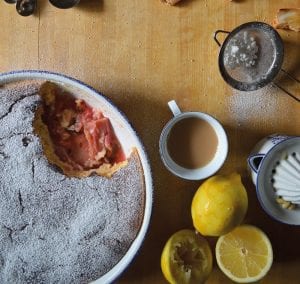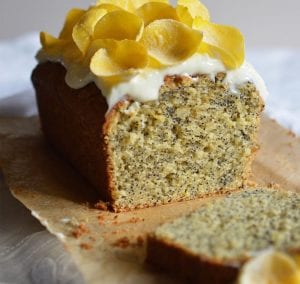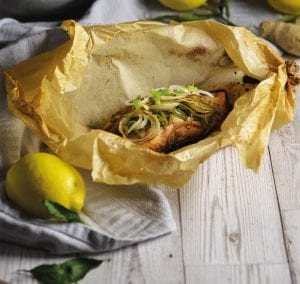As the chill of winter bites, hunger strikes as our animal instinct is to fuel up. Our stomachs hanker for warm and comforting, yet nourishing food. Recipes from Katie Kingsley.
Saucy lamb shanks

This is a great alternative to a Sunday roast and guaranteed to satisfy at a dinner party. There is enough sauce for six lamb shanks, if you wanted to serve more people. I think these are delicious on a bed of risotto Milanese. Ultimate comfort food!
Preheat your oven to 180°C. Rub rapeseed oil into four lamb shanks and season well. Heat a pan to a medium-hot heat and brown the shanks all over (about two minutes on each side) then set aside. Add more oil to the pan if it is a little dry and then add your sofrito (two celery stalks, two carrots and a large onion) all chopped fine with four minced garlic cloves. After about five minutes and as the vegetables begin to brown, add 5 tbsp of tomato paste, cooking out for a few minutes before then adding 400ml of red wine, 200ml of white wine, 3 tbsp of white wine vinegar, leaves from a sprig of fresh thyme, two bay leaves, 2 tsp of black peppercorns, 2 tsp of juniper berries, five chopped anchovy fillets then bring to a boil and cook for five minutes to burn off some of the alcohol before adding 500ml of chicken stock.
Add your shanks to the pot returning to a boil before securing the lid and placing in the heated oven for one hour (or simmering on the hob). Remove the lid and continue to cook the lamb at a gentle simmer for three hours or until very tender, turning every half hour. The meat should be falling off the bone. Carefully remove the shanks and pour your braising liquid through a sieve, discarding the solids. If you want to thicken the sauce, simmer this down for longer then serve your shanks on a bed of risotto Milanese and pour over your sauce.
Smoked haddock and corn chowder

An excellent mid-week supper, really simple to put together, wholesome and nutritious, it ticks all the boxes! This can also be adapted to keep it seasonal, peas, asparagus, spinach or diced tomatoes are great additions, frozen sweetcorn is respectable instead of fresh and tarragon or dill can be used instead of or in addition to the thyme.
Melt a generous knob of butter in a deep pan, (I use a casserole) then add four finely sliced leeks. Sprinkle over your chosen herb (thyme leaves, chopped tarragon or dill) and cover with a circular piece of baking paper big enough to tuck down around the sides of the leeks. Put the lid on your pan, cooking the leeks for 10 minutes then lift off the lid and paper, add sweetcorn from two cobs and 250g of halved new potatoes, place the paper back on top, tuck around the edges again, replace lid and cook for a further 10 minutes.
While this cooks, poach a 300g piece of smoked haddock in whole milk (enough to cover the haddock in a small pan) with two bay leaves and a sprinkle of peppercorns for about 8 minutes. When cooked, empty the pan contents over a sieve, reserving the milk. Discard the pepper and bay leaves then remove any skin and break up the fish with your hands into chunks taking care to remove any bones. Remove the lid from your vegetables then add the haddock and milk bringing to a simmer then finish with a handful of freshly chopped parsley. Serve in bowls with crusty bread.
Rhubarb pudding

This dessert is not overly sweet, the sharpness of the rhubarb follows both recipes well as it cuts through the richness. I like to serve this with ice cream or thick cream. Make sure you bake the pudding in a shallow dish that fits into a roasting dish as you will need to bake it in a bain marie.
Preheat oven to 170°C. Trim and cut rhubarb stalks into 4cm pieces (you need about 600g) then lay them in an ovenproof dish. Scatter over 50g of caster sugar and 3 tbsp of water then bake for 20 minutes until the rhubarb is tender but intact. Butter a shallow two-litre baking-dish then carefully remove the cooled rhubarb with a slotted spoon and place in the dish. Separate three large eggs and beat the yolks with 175g of caster sugar until pale and light. Add the zest of two lemons and juice from 1 then fold in 75g of self-raising flour and 150ml each of single cream and milk. Beat the egg whites with 1/2 tsp of cream of tartar until stiff and glossy then fold into the batter with a large metal spoon. Pour the batter over the rhubarb and set the baking dish into a larger dish (such as a roasting tin) then pour in boiling water to reach halfway up the sides of your baking dish. Bake for an hour until puffed and golden, sift icing sugar on top and serve warm.
















